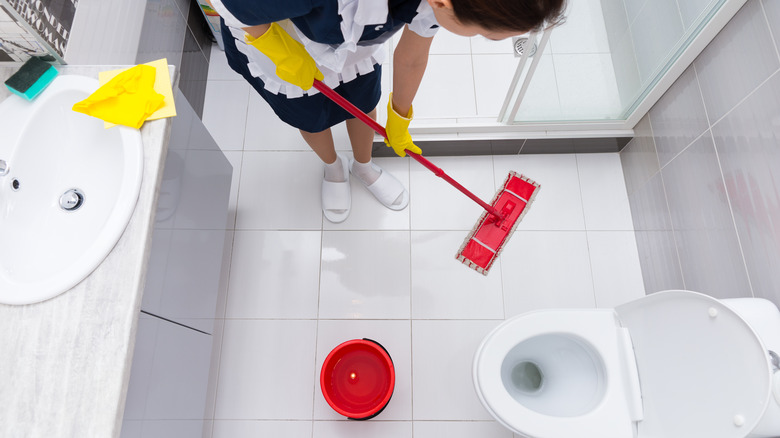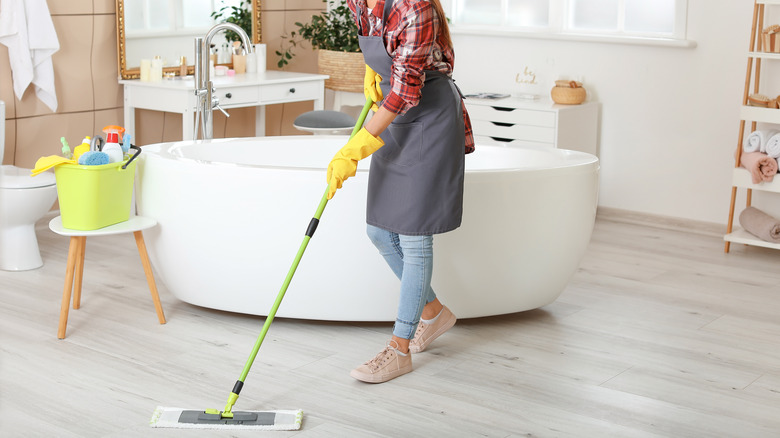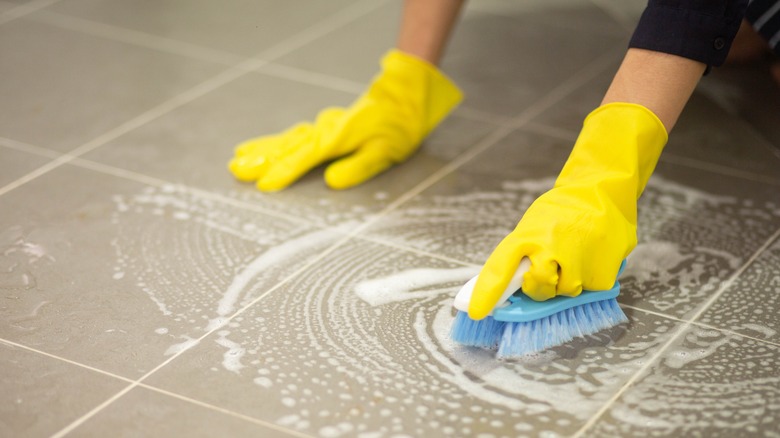You're Probably Not Cleaning Your Bathroom Floor Often Enough
Your bathroom: The sanctuary of cleanliness, the fortress against germs, or so you may think. While many diligently scrub their toilets, washbasins, and bathtubs, there's one crucial area that often gets overlooked — the bathroom floor. To keep this part of your bathroom pristine and hygienic, make sure you give it a proper clean at least once a week.
Bathroom floors are prime real estate for microbial growth. They're constantly exposed to moisture, warmth, and organic matter, creating the perfect environment for bacteria, fungi, and even viruses to thrive. So, while you diligently wipe down your sink and clean your toilet seat, the floor remains a haven for these unwelcome guests. In fact, a study by SafeHome.org revealed that bathroom bacteria levels appear to be highest on the shower curtain and the shower floor, with 16,240,000 and 15,883,333 colony-forming units (CFU) respectively. So, after taking a shower, you may end up tracking microorganisms, including pathogens, to the rest of your bathroom floor. Also, a study in Biofilms and Microbiomes encompassing ten households revealed interesting findings regarding the microbial composition of bathroom floors. Based on the results, 40% of the microbes present on the floors originated from the skin, outnumbering those associated with "faecal, vaginal and urinary origins," which accounted for only 30%. The germs lurking on your bathroom floor can easily spread to other surfaces, leading to cross-contamination and potentially causing illnesses. Plus, let's not forget about the unpleasant odors that can arise from neglected floors.
Steps to achieve a clean bathroom floor
To maintain a truly hygienic bathroom, include the floor in your cleaning regimen once a week. However, how often you should clean your bathroom floor also depends on factors like household size and how frequently the bathroom is used. Clean the bathroom floor every few days if you have a larger household or bathrooms that see heavy use. If someone ill is using the bathroom, clean the floor more frequently — daily, if possible — to prevent the accumulation of dirt and germs, as well as cross-contamination.
Before cleaning your bathroom floor, open the windows to allow fresh air to circulate. If you don't have windows, use a fan instead. Remove clutter, dust, and debris from the floor to ensure the surface is clear, so it's easier to achieve a thorough clean. Next, use a microfiber cloth or a mop, along with a mixture of warm water and soap (or your chosen floor cleaning agent) to clean the floor. For a deeper clean, especially if you're dealing with tough stains or microbial buildup, consider using an alcohol- or bleach-based product, making sure to follow the manufacturer's instructions. Then rinse the floor thoroughly, wipe it down, and let it air dry completely. Keep the bathroom off-limits until the floor is thoroughly dry. This precaution ensures your and your loved ones' safety and helps optimize the effectiveness of the cleaning process.
Tailored cleaning based on floor material
The method you use in cleaning your bathroom floor will also depend on the type of flooring, as each material requires different care. For tile floors, start by sweeping or vacuuming the surface to remove any loose dirt and debris. Mix a solution of warm water and a regular detergent or all-purpose cleaner. Scrub the tiles with a soft-bristled brush or a sponge mop, paying extra attention to grout lines where dirt tends to accumulate, then rinse thoroughly with clean water.
If you have a natural stone floor like marble or granite, use a cleaner formulated for the specific stone material as harsh chemicals can etch or dull the surface. Clean it with a stone soap or mild detergent, and a soft mop or cloth. If you have vinyl flooring, opt for a pH-neutral cleaner to prevent damage. Follow the manufacturer's instructions and mop the floor, working in small sections, and then rinse with water. Another option would be using a soft cloth soaked in a solution of equal parts warm water and white vinegar to clean the floor.
Don't forget to sanitize the floor to kill germs effectively. A solution of bleach and water can help keep your bathroom floor clean and hygienic. For stone floors, use a rubbing alcohol and water solution for disinfection. With the right tools and techniques, you can ensure that every inch of your bathroom floor is sparkling clean and free of germs.


